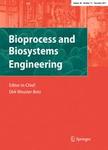版权所有:内蒙古大学图书馆 技术提供:维普资讯• 智图
内蒙古自治区呼和浩特市赛罕区大学西街235号 邮编: 010021

作者机构:Chinese Acad Sci Hefei Inst Phys Sci Key Lab High Magnet Field & Ion Beam Phys Biol Shushanhu Rd 350 Hefei 210031 Anhui Peoples R China Univ Chinese Acad Sci Beijing Peoples R China
出 版 物:《BIOPROCESS AND BIOSYSTEMS ENGINEERING》 (生物工艺和生物系统工程)
年 卷 期:2021年第44卷第7期
页 面:1373-1382页
核心收录:
学科分类:0817[工学-化学工程与技术] 08[工学] 09[农学] 0901[农学-作物学] 0836[工学-生物工程] 090102[农学-作物遗传育种]
基 金:Hi-Tech Research and Development Program of China (key 863 Fund of China) [2014AA021704] Natural Science Foundation of Anhui Province [1308085MA07, 1608085QC46]
主 题:Biofilm lipid peroxidation Gamma ray mutagenesis Low-energy ion implantation Menaquinone (MK) SOD activity
摘 要:By comparing the survival rate and positive mutation rate of the primary mutagenic strain and progeny mutagenic strain under different radiation doses, the results showed that the tolerance of the mutagenic strain to radiation dose increased with the increase of the mutagenic generations. We adopted an improved gradient radiation breeding strategy to improve the breeding efficiency. The strains were treated with radiation in four stages. The first stage was low energy N+ ion implantation (ion energy 15 keV, dose 80 x 2.6 x 10(13) cm(-2)). In the second stage, the energy and dose of N+ ion reached to 20 keV, 90 x 2.6 x 10(13) cm(-2). In the third stage, Co-60-gamma radiation (dose of 1.56 kGy) was used. In the fourth stage, the radiation dose of Co-60-gamma increased to 1.82 kGy. After each stage of radiation, the MK (Menaquinone) precursor 1, 4-dihydroxy-2-naphthalate (DHNA) was used as the stress factor to domesticate the mutant strains. By gradually increasing the concentration of DHNA in the culture medium, the substrate tolerance of Flavobacterium sp. was effectively improved. By measuring SOD (superoxide dismutase) activity and malondialdehyde, it showed that the cell damage caused by radiation mutagenesis to the offspring mutant was less than that of the primary mutant. Changes in membrane permeability and membrane potential of the mutant strains were reflected in changes in fluorescence intensity of luciferin diacetate and rhodamine 123, which could explain the enhanced substrate tolerance of strain F-2. After gradient radiation breeding and culture acclimation, the biomass of mutant Strain F-2 was 6.59 g/L, and the MK yield was 9.59 mg/L.